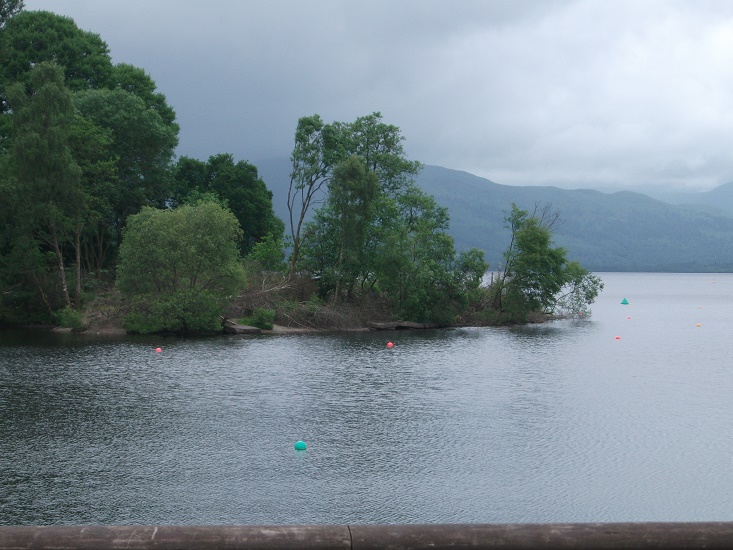
Three months ago, following the felling of over 100 trees by Drumkinnon Bay in Balloch I asked the question what was going on (see here)? In mid-June the police arrested a man from Alexandria in connection with the felling (see here) but there have been no further announcements about whether he was acting on someone’s order and if so who was ultimately responsible.
While it is course possible that no-one else was involved and this man, if the police have got the right person, acted off his own bat, that seems unlikely. Other men had been seen chopping trees the day before and while someone with a grudge might say chop down one tree, over 100? On account of this it seems reasonable to assume the man/men were commissioned to commit the crime on behalf of someone else and the lack of news suggests they were paid enough to make it worth their while to keep mum and take the rap.
There have been plenty of rumours circulating the Balloch area about who that someone else might be and my previous post mentioned two possibilities, the Wedding Business who now leases the former National Park Gateway Centre and Flamingo Land, to which I would now like to add a third, the European open water swimming championships. This post considers the possible motives behind the tree chopping – there may be others – and argues that, because of the potential ramifications, its in the public interest and of the organisations considered here that sufficient resources are dedicated to the police investigation to come up with definitive answers soon. The innocent should not have to suffer for the actions of others.
Potential motivations for the tree felling
The key thing to appreciate about the felling is that, had it been completed, it would have opened up views which were previously obscured by trees. The main view lines prior to the tree felling were helpfully illustrated in Flamingo Land’s Design Statement and were on the east side of Drumkinnon Bay:
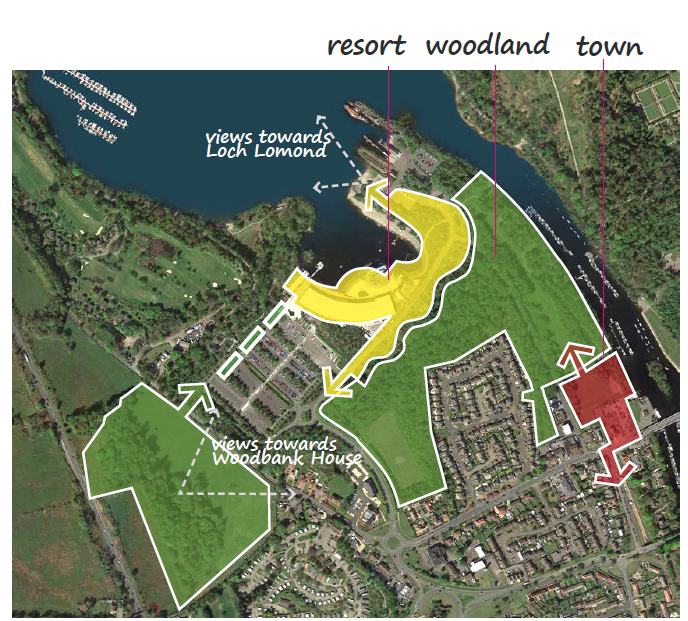
The headland on the West side of the bay offered very limited views and also effectively blocked views out over the Loch from much of the Lomond Shores development.
The limited views from the headland itself prompted speculation that the wedding business at the former National Park gateway centre might have been responsible for the tree felling, the suggestion being that they may have wanted to create better areas for photographing wedding guests (Loch Lomond being a lot more attractive than Lomond Shores).
Similarly, while the views out across Drumkinnon Bay are not relevant to most of the Flamingo Land Development, they also have an interest in the views from the headland as they are proposing a small luxury development by the old boat house there:
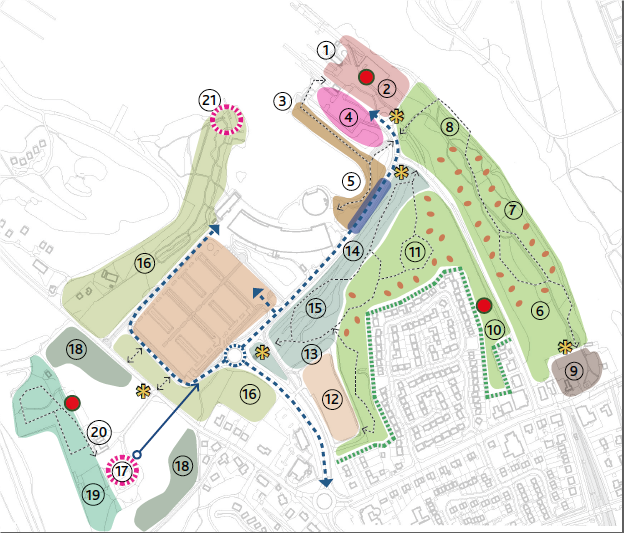
A question for the LLTNPA therefore is whether the tree felling has, or was intended to, improve those views? If so, it would appear that the LLTNPA could potentially be condoning a crime by progressing the Flamingo Land Planning Application before the Police Investigation is complete.
There has, however, been another planning application (see here) which was approved on 28th June for which the views across and out of Drumkinnon Bay are of great importance. This was from Glasgow City Council for the European Open Water swimming championships. Part of the temporary structures included in that application were for scaffold stands for broadcasting cameras and stands for the viewing public on the beach at Drumkinnon Bay below Lomond Shores. The location of the broadcasting stands, as illustrated in the Field of Play Broadcasting Positions document raises questions about the tree felling:
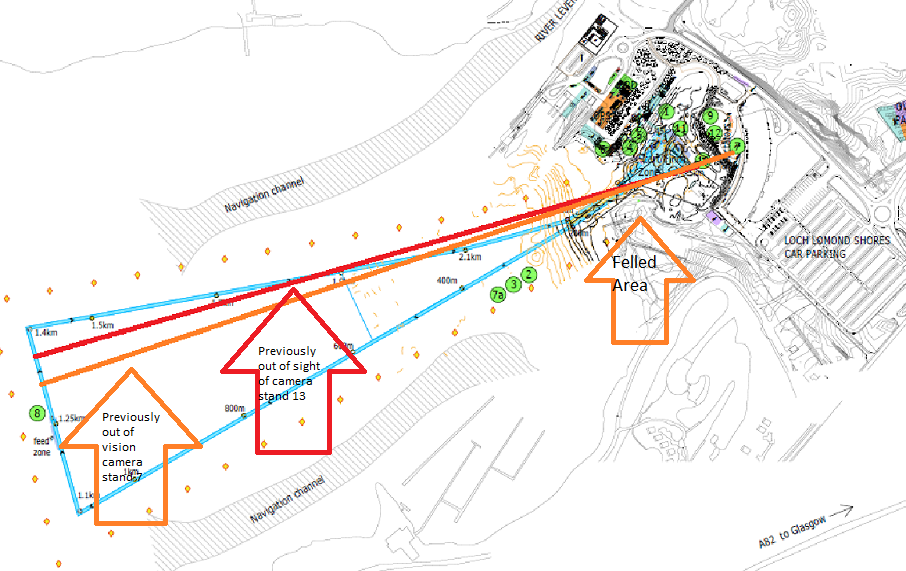
Anyone trying to sell or buy the rights to use the positions with limited might therefore have had an incentive to chop down the trees. 1.4bn people are expected to watch the European Championships and the broadcasting rights are not just worth a fortune but key to the success of the event.
Of the planning documents which are still on the portal – one might ask why LLTNPA has already removed the Supporting Statement (which luckily I saved 2018_0131_DET-Supporting_statement-100305344) – none say anything about the limited views from some of the camera positions. They do ostensibly however refer to the need to protect trees with the Supporting Statement including this:
Due to the sensitive nature of the environment, no modifications to existing landscape including trees or foliage will be considered. All habitats will be maintained as exist and where required existing landscaping (trees etc) will be protected.until it has been established who is
And the LLTNPA has imposed a condition requiring all trees to be protected:

So that’s all ok then? Well, I am not so sure because of the way an earlier planning application relating to the European Open Water swimming championships was approved without any regard for conservation.
The dredging of Drumkinnon Bay
After it was decided that the open water swimming part of the European Championships should be held in the National Park, a planning application was submitted to dredge part of the course because it was too shallow to meet the sport’s requirements, e.g for safe diving at the start. One might have thought this should have been checked BEFORE deciding on the venue.
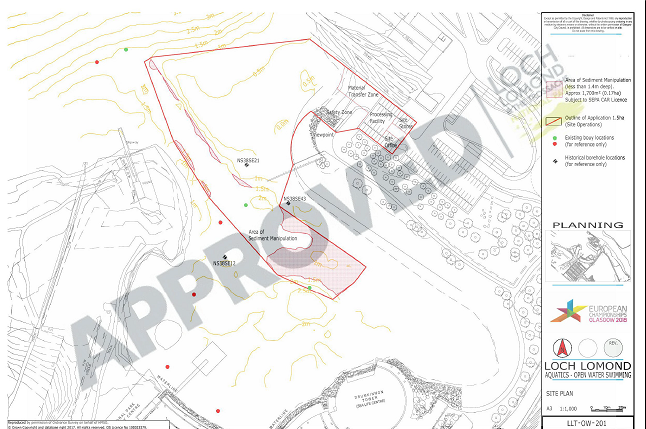
And, more importantly, given this is a National Park, someone would have checked its conservation value but in the race for glory and to please politicians, the whole deal was signed off without a proper feasibility or impact study. Had this taken place, it would have become apparent that this was one of the main known spawning grounds for the powan, one of Loch Lomond’s special fish and a relic from the ice ages.
There is no mention of the powan in any of the planning papers (see here), no response from Scottish Natural Heritage – a pretty amazing omission – and the response from SEPA to an application which involved shifting 1000 cubic metres of material is very interesting:
| Scottish Environmental Protection Agency
SEPA have advised that they have no objections to this proposal and have advised that: · This activity would require a simple licence under The Water Environment (Controlled Activities) (Scotland) Regulations 2011 (as amended) (CAR) and, based on the information received to date, SEPA consider this activity is potentially consentable under CAR. · The CAR authorisation will have a condition attached which requires the submission of a Method Statement to be submitted and approved by SEPA prior to works commencing. As such there will be no requirement to attach a condition to any grant of planning consent for a Method Statement to ensure protection of the water environment for these works. · The proposed temporary access slipway at the beach will also require authorisation but this can be incorporated into the dredging licence authorisation. · Drainage from the processing facility and material transfer zone will have to be adequately managed to ensure that it does not cause a polluting discharge back into the loch. Any discharge to the loch from this area would also require authorisation under The Water Environment (Controlled Activities) (Scotland) Regulations 2011 (as amended). · The removal of the material from the loch and its potential treatment on land may require waste management authorisation and SEPA can advise the applicant on this.
|
Usually SEPA objects to any application where sufficient details are not submitted to enable it to assess the impact of any development on water quality but in this case all of that seems to have taken back seat. Its hard not to wonder why?
The Decision Notice issued by the LLTNPA in January required the applicant to submit further documents, the first of which was:
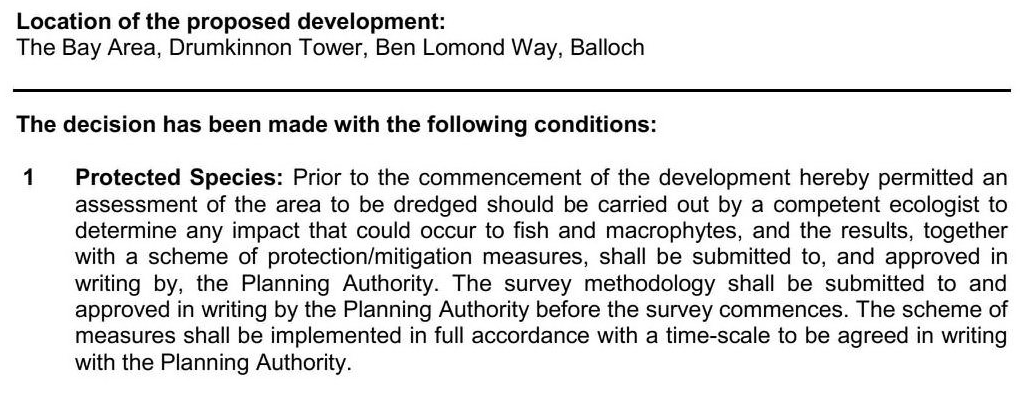
That didn’t give much time to assess the impact of the powan and its unclear from the planning portal whether a proper assessment was ever submitted or approved. This is yet another case of the LLTNPA, which prides itself on winning planning awards, failing to make public crucial documents. It is hard not to be suspicious particularly since its attitude towards dredging in this case appears to have been far more lax than in other cases such as the widening of the A82 at Pulpit Rock.
So, what conclusions can be drawn from this?
I have tried to illustrate that several organisations – and there could be more – might have had a motive for felling the trees at Drumkinnon Bay. This is not to claim that any of them is responsible but rather to show that there are massive public interest questions here and until those are answered, the whiff of major scandal will hang both over the National Park and those organisations that are innocent. The issue quite simply is whether conservation has been sacrificed for commercial interests and if so, who, if anyone, in our public agencies was aware of this? To state the obvious, its in the interests of everyone except the culpable that the police investigation is successful as soon as possible.
The LLTNPA has made the situation worse through its lack of tranparency and willingness to take shortcuts to put economic activities, such as the European Swimming Championships, and development , such as Flaming Land, before conservation and public enjoyment of the National Park. Its warped priorities are illustrated by its plans to close the Duncan Mills slipway, the last remaining public boat launching place on the loch, during the European Swimming Championships without any consideration of alternatives. Unfortunately it seems incapable of standing up for those things that prompted the creation of the National Park in the first place.
The chopping down of the trees was not a one man job,who ever is behind it should be prosecuted and made to replant the area.
Glasgow city council have a history of cutting trees down. When the LLTNPA close the Duncan Mills Slipway, will they reopen it .loch Loch Lomond belongs to the public. Once again I like two say a big thank you to parkswatchscotland your doing a brilliant job
This vandalism by vested interests and the authorities is shocking. In the past work was stopped at the Tower to allow the powan to spawn undisturbed. Were Colin Adams at the Field Station or the biologist at L. Lomond Fisheries Trust consulted? It doesn’t look like it. The role of SEPA and SNH have become crystal clear to me, following no end of exchanges with them. They are not there to serve and support the public interest. Their job is to act as a gatekeeper between the public and the private business interests in land and development…to keep the public out and attend to the private business interests exclusively. This provides a redistribution of Government funding and support, manpower and expertise in favour of the private business interests at public expense. The enforcement of regulations is strictly light touch. In one case, Pete Murray, the Team Leader on the L Lomond Catchment Management Plan, said a bit too much about the pollution on L Lomond. He was swiftly “disappeared” to the South Side of the Clyde and retired shortly thereafter. This isn’t a National Park. It’s a funding and support platform for the private business interests. For generations people would go to L Lomond and The Trossachs and wander around free as a bird and without a care in the world…and everyone knew their countryside code. Now it’s a labyrinthine nightmare of rules and regulations and intrusive tourist attractions, hawkers, fiddlers and fleecers. Our natural and cultural heritage has been killed, stone dead and buried.
From my experiences in the Cairngorms National Park, I have examples of, in particular, SEPA taking a very light touch in commenting on planning applications and on turning a blind eye to potentially illegal activities of developers. It’s interesting to see that you have similar experiences. My impression is that SEPA at a senior level is keen to to seen (by our Scottish Government) to support developments and find a way of fudging the negative environmental impacts.
Why does your report make a spurious claim about people with mental health? If I i have missed something then please enlighten me. Your example of someone with mental health chopping down trees is very poor and polarising for those who suffer.
Hi Doug, my apologies, I did not intend my text as originally phrased to say anything about people with mental health problems but rather to illustrate that the likelihood of any individual deciding to chop down these trees is extremely unlikely and something else is behind this. I have removed it.
Excellent post as always Nickel except the part about mental health which I feel should be removed as you are aware west Dunbartonshire has a high number of people with mental health issues as does Scotland and I really don’t think it’s appropriate at all to be mentioned in your article sorry